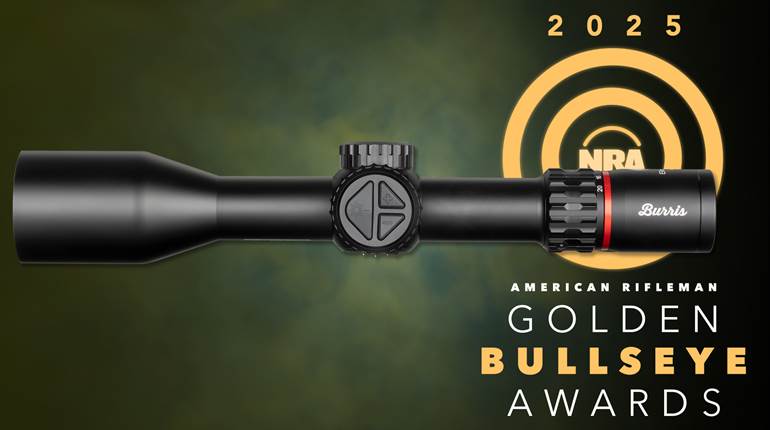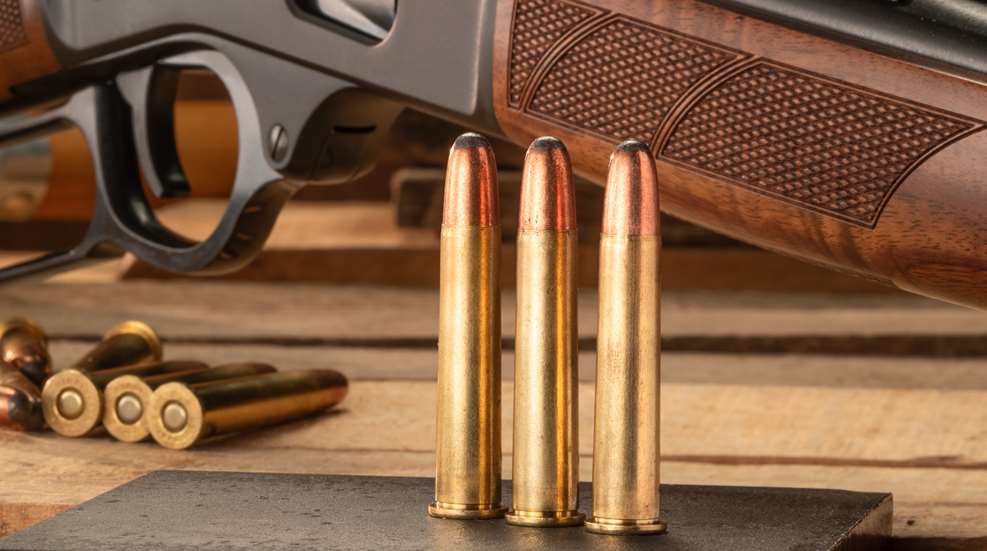
If necessity is said to be the mother of all invention, then it’s also fair to say that legislation breeds innovation. As I hail from a firearm-restrictive state, New York, I have lived through the advent of fixed-magazine AR-15s, 49.6-oz. handguns and rifle grips that fit every description other than “pistol.” To that end, when states started to announce that they were going to ease hunting restrictions to allow the use of reduced-range cartridges, I quickly saw the writing on the wall—a straight wall in this instance.
Seemingly overnight, the backdrop was filled with cartridges explicitly built for this niche, which is to be expected. Although I don’t think anybody expected the Remington brand to be back and in a position to introduce such new products so quickly, that is precisely what we have here in the 360 Buckhammer. It is Remington’s entry in the competition to be the most powerful .35-cal. straight-walled cartridge in the woods, and it also happens to be lever-action friendly.
While the distinction between straight and tapered cartridges previously only meant something to gun builders and handloaders, it has more recently been used as a simple way to distinguish long-range ammunition from short-range ammunition. The goal of the legislature was to allow hunters to use firearms that were more accurate and softer-recoiling than shotguns for medium- and large-game hunting, yet still protect nearby homeowners from the (albeit rare) danger of a stray bullet or ricochet.
The idea quickly grabbed hold, as many hunters already owned firearms that fit the descriptions set forth by state law. Once afield, however, they realized that many of these cartridges had limitations that precluded their use for deer hunting. Issues stemming from effective range to bullet performance started to rear their ugly heads, turning many hunters back to their faithful slug guns. Spotting this regression, Winchester introduced the 350 Legend cartridge, which caught on like wildfire. Many deer hunters favor larger-than-.30-cal. bullets, with a certain fondness for the .35-cal. in particular—if you don’t believe me, bring up .35 Remington to any serious woodland hunter and watch his or her face light up.
Winchester certainly had a hit on paper, but it, too, suffers from a few maladies. First, it was designed on a rimless case, taking it out of the running for a conventional lever-gun chambering. Second, its case is shorter than it needs to be. At 1.710", it is almost a tenth of an inch shy of the 1.800" case length that most, if not all, states mandating straight-wall cartridges for certain hunting areas or seasons have declared as their maximum allowance. This might not sound like much of a limitation, but, in practice, that is nearly enough room to turn .38 Special into .357 Magnum. For reference, this number was supposedly the longest practical handgun cartridge length recorded by SAAMI when these laws grabbed foot. Many states felt it would be easier written and understood as “pistol-caliber rifles are now okay” instead of making hunters calculate muzzle energy.

Big Green Pushes It
Remington Ammunition has a long history of making excellent deer-harvesting products. But, for the last few years, it simply didn’t have the means. Ravaged by bankruptcy and lackluster management, any projects on the drawing board sat in stagnation, including a project to chamber a Marlin 336 in .357 Rem. Max., showing that the company was already thinking in the .35-cal. straight-wall direction. Alas, the famed manufacturer succumbed to financial ruin and would eventually be broken up, with the ammunition portion acquired by Vista Outdoor to join brands such as Federal Premium, Speer and CCI. Needless to say, Remington’s new holding entity helped the brand realize its potential to produce better products, so, with that, the 360 Buckhammer project returned to the forefront.
Now, I don’t want to automatically paint it in the light of “a better 350 Legend,” although the numbers do indeed indicate that it has more muzzle energy and less drop while only adding a marginal amount of recoil. While the “better mousetrap” approach to marketing is classically a sound method, Remington prefers the idea of putting it in front of .30-30 Win. owners as a familiar cartridge in a friendly platform that they can legally use during deer season. When compared to lever-actions chambered for the like, those that cross over get to retain the same manual of arms and similar trajectories as granddad’s favorite woodland companion.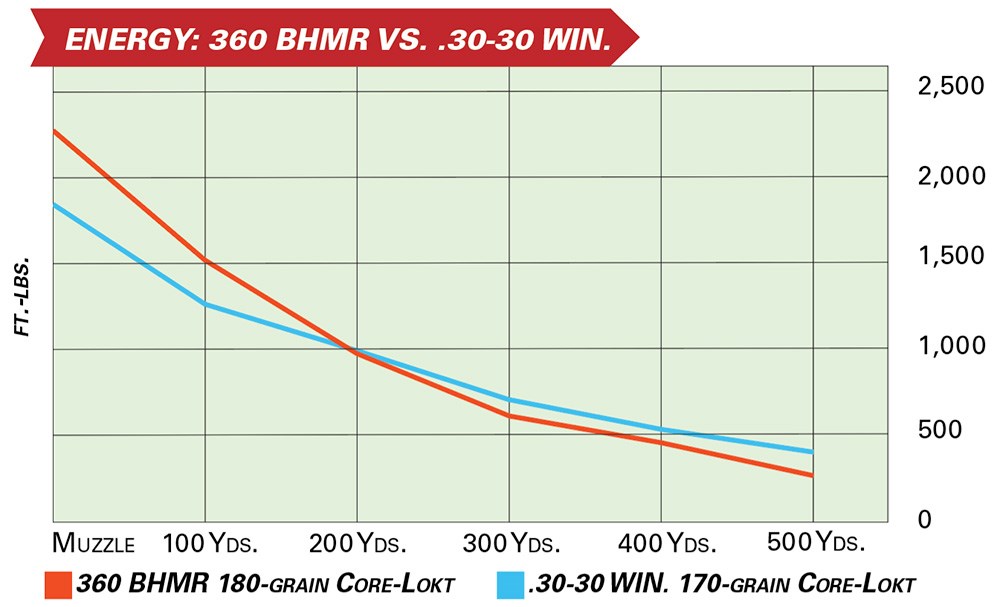
From Dream To Reality
As previously mentioned, the story of the 360 Buckhammer started somewhere around 2016 with Remington’s senior research engineer, Ricky Buckmaster (yes, that is his real name). The specifics were a response to the request of the company’s director of ammunition product management, Nick Sachse. Sachse envisioned a straight-wall cartridge that had more power than .30-30 Win., comparable ballistics and recoil that was as tolerable or even less than that of the classic when loaded with the same weight bullet. Knowing that the .357 Rem. Max. didn’t have the capacity to get there, could the solution be as simple as not necking down a .30-30 case? It turns out that, yes, yes it could.
Using this readily available parent case, .30-30 Win. brass is pulled off the line at the early stages of its creation, and instead of receiving the bottleneck treatment, it is tapered to accept a 0.358"-diameter bullet and trimmed to 1.800" with a tolerance of 0.02". This allows Remington to load the cartridge with the same time-tested bullets that are featured in its other woods-worthy .35-cal. ammunition and keeps it legal in the states that dictate a maximum case length. Call me sentimental, but a certain feeling is associated with holding a cartridge built from elements of several iconic deer classics rolled into one. It’s unique, almost like finding a well-preserved surplus rifle and getting it for a steal.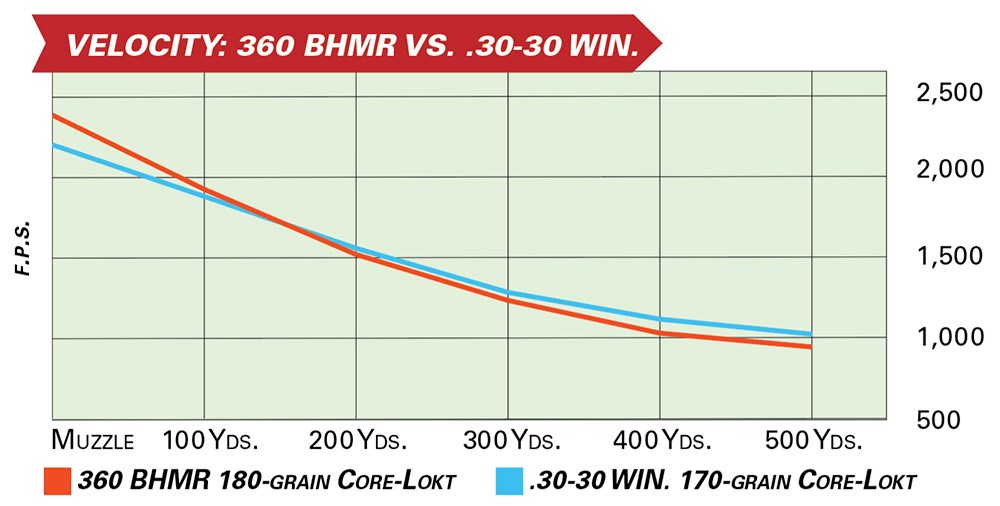
Quick-Performing Projectiles
One of my favorite features of this cartridge is that Remington didn’t try to re-invent the wheel during its creation. Needless to say, there won’t be any EtronX loadings anytime in the near future. No, instead, Team Green utilized the bullets its hunters desired most, which are rolled off of its presses in Lonoke, Ark. At the time of this writing, inaugural loads will consist of 180- and 200-grain soft points from the prestigious Core-Lokt line. Although both have sluggish G1 ballistic coefficients (0.178 and 0.181, respectively), their larger diameter and generous exposed lead tip work in conjunction to produce hydrostatic shock at lower velocities than narrower, even heavier, designs.
It also pays to mention that the cartridge isn’t intended for engagements beyond 200 yards. However, in your typical hunting scenario, shots are usually half of this distance, so the close-range knockdown power is an easy trade for wind-beating properties that most likely won’t even come into play. On the same note, their somewhat low sectional densities of 0.201 and 0.223, respectively, are positive in this instance, as they will shed velocity rather quickly after impact. This lends them to safer service near residential areas without sacrificing close-range lethality.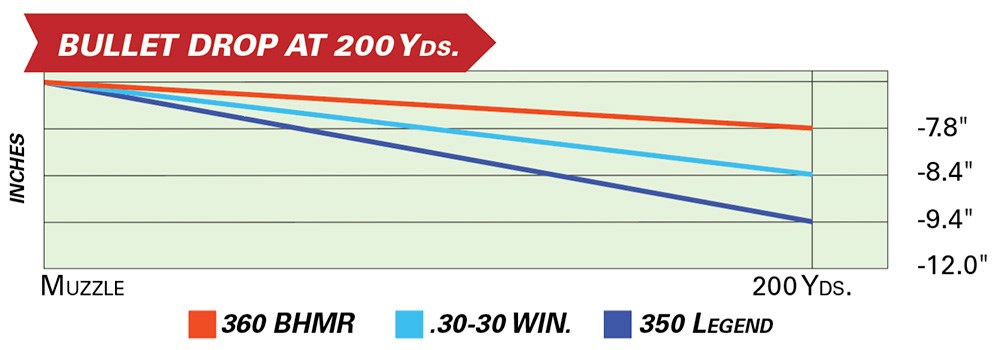
Getting the powder type and charge just right for the 360 Buckhammer was a bit of a challenge, as maximum velocity was the goal. A 360 Buckhammer holds only 44.2 grains of water compared to the 47.1 grains of its parent .30-30 Win.’s case, which is a significant difference. Limited capacity, coupled with a relatively thin case wall, put powder selection into a narrow range. Essentially, if the burn rate was too slow, Remington couldn’t get enough of it into the case to produce effective velocities. Going with a faster-burning powder would threaten the team with pressure issues. Together, these properties greatly limited the selection of usable powders until it was discovered that powders with burn rates similar to Accurate 1680 yielded the best results with acceptable accuracy for medium- to large-game hunting.
Putting It All Together
Now for the most important question: How does the new cartridge measure up to its parent and its closest competitor? When comparing the 180-grain Buckhammer load to Remington’s 170-grain .30-30 Win. load, we see a muzzle velocity increase of slightly more than 200 f.p.s. but a free recoil increase of only 2 ft.-lbs. This represents a negligible effect to even a bare human shoulder, let alone one clad in several layers of thick hunting clothes.
Velocity gets more interesting toward the end of each projectile’s effective range of 200 yards. At this point, the .30-cal. bullet surpasses the .35-cal. projectile by approximately 60 f.p.s. However, given that the round fired out of the 360 Buckhammer case is heavier, it only results in an energy loss of about 21 ft.-lbs. This puts it within 2 percent of the .30-30 bullet at the same distance. By the numbers, Remington found a way to manage recoil without noticeably sacrificing lethality, making it easier on new shooters without handicapping them in the field.
When comparing it to the 350 Legend, things get drastically different. While the Legend’s 180-grain load produces 2.5 ft.-lbs. of free recoil less than the same weight Buckhammer load, it’s coming out of the muzzle 300 f.p.s. slower—which creates a deficit of more than 530 ft.-lbs. of muzzle energy. Things don’t truly start to even out until you hit the 200-yard mark, but, even then, the Legend is 40 f.p.s. slower and generating about 60 ft.-lbs. less energy. If you’ve ever hunted some of the states where this is likely to be used, it pays to capitalize on the short game, as most shots aren’t much farther than 50 yards.
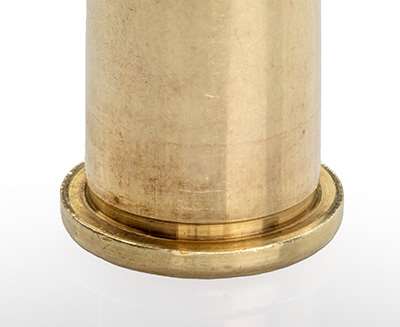
The Shooting Iron
New cartridges are great, but you can only promote them so much; if there aren’t quality firearms coupled with their release, they can fail to catch traction in the market. While the Remington ammunition brand suffered during the bankruptcy and restructuring process, it has gained a new lease on life through Federal and its exceptional relationship with Henry Repeating Arms. Always happy to add a new offering to its lineup, the Wisconsin-based manufacturer known for its lever-actions jumped at the opportunity to chamber a rifle in the new cartridge.
Again, there was no need to start from scratch, as the company’s H009G .30-30 side-gate rifle was almost completely there—all it needed was a new barrel. Early models featured a 20" barrel and were cut with a 1:14" twist, however, as suppressors and subsonic fodder are becoming increasingly popular in a hunting setting, production models will wear a faster 1:12" twist. This also prepares them for monolithic bullets, which are harder to stabilize due to their longer design. Of course, if an H009G can be readily made to fire 360 Buckhammer, there’s no reason not to expect threaded models like the Henry X or perhaps even shiny brass versions to hit center stage once things get going.
I learned of the 360 Buckhammer and the new Henry rifle on the firing line at a media event when Remington brand representative Jonathan Harling handed me a rifle and the new cartridge. After pressing the trigger and watching a steel plate nearly dance off its hanger at 100 yards, he asked if I would be able to field-test the new equipment later that year in Ohio on a whitetail hunt; I accepted.
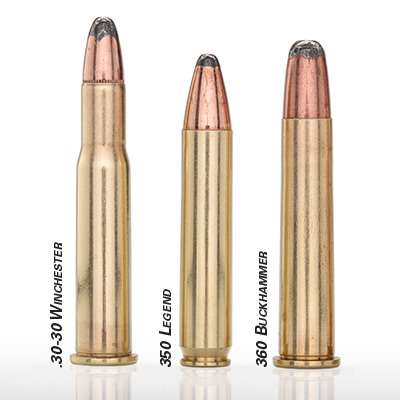
Home On The Range
I arrived at the lodge the day after Thanksgiving and unpacked my gear as I waited for the other five hunters to make their way to camp. Shortly after, our host stepped in and supplied us with targets and a shooting rest to confirm the zero on our rifles. Before the hunt, the folks at Henry and Remington were gracious enough to set up each rifle with a Leupold VX-Freedom 2-7X 33 mm optic and get us on paper before shipping them out. With a case of 200-grain Core-Lokts at our side, we had everything we needed to center up right off the back deck—well, except for nice weather. No less than 35 m.p.h. winds plagued our range session, and we had to do the best we could to punch groups between gusts. Most of us settled on an inch-high 50-yard zero, as it was the best way to eliminate wind-induced error.
During the process, I was reminded how swift subsequent shots could be with a lever gun and was able to shoot and follow up before the wind changed. The Henry is also an inherently lefty-friendly design, so I didn’t have to listen to anybody’s smart-aleck remarks as to how I work a bolt. Even in its heaviest load, shooting the 360 Buckhammer was a treat. Although I was wearing just a light sweatshirt, my shoulder didn’t feel like it had just fired 40 rounds of .35-cal. ammunition, and I was able to keep my sights on target all the way through each shot. That’s a critical function for any hunting rifle, as game needs to be observed immediately after a round is cracked off to ensure it dropped or to see which direction it ran for tracking purposes.

With our rifles ready for action, we made it an early night as we were set to be in our blinds before first light for the next five days. It was one of the better decisions in my life as, unbeknownst to us, we were in for some tough hunting. After seven four-hour sessions of not seeing much of anything, I made a decision to take a buck with poor genetics.
Emerging from the brush line at last light, he wasn’t going to come any closer than 118 yards (measured with a rangefinder), so when he turned broadside, I let him have it. Hearing the bullet strike meat, I watched him jump and run 53 yards toward my position before sliding to a crashing halt. My shot passed through, puncturing both lungs and leaving an exit wound measuring approximately 1.5" in diameter. Since it was only 0.358" going in, it’s fair to suggest that the bullet still had enough punch left for reliable expansion at that distance. Retracing his path, we found a prominent blood trail along its entirety, as well as obvious signs of an impact where he originally stood. This is another vital quality of a hunting cartridge, as not all recoveries are as smooth as this one.
With my buck tag punched, I was offered the opportunity to take a doe. Since I still had room in the cooler and a full day left, I figured, why not? The first half of the day was a little slow, but magic struck again at last light. A meaty doe decided to take a stroll down the path to my right, which was a direct route to a food plot. Again, I had my work cut out for me because she just wouldn’t turn enough to give me a shot that would preserve any meat. With that, I knew it would take a neck shot to seal the deal. But that would prove difficult, as I was in an elevated position, and I reasoned that the bullet would pass through her neck and back and lodge in her gut sack, destroying nearly every piece of meat with a single shot. As she closed the 60-yard space between us, I cocked the hammer, put my crosshairs next to her head and tracked her as she came in, hoping for some sort of window. When she reached a distance of 54 yards, she stretched her neck to the right to get a better whiff of whatever was blowing across the field. This gave me about 4" to work with that were directly in line with the ground. Confident in my ability and my gear, I released the shot and laid her out right where she stood without losing so much as a scrap of stew meat.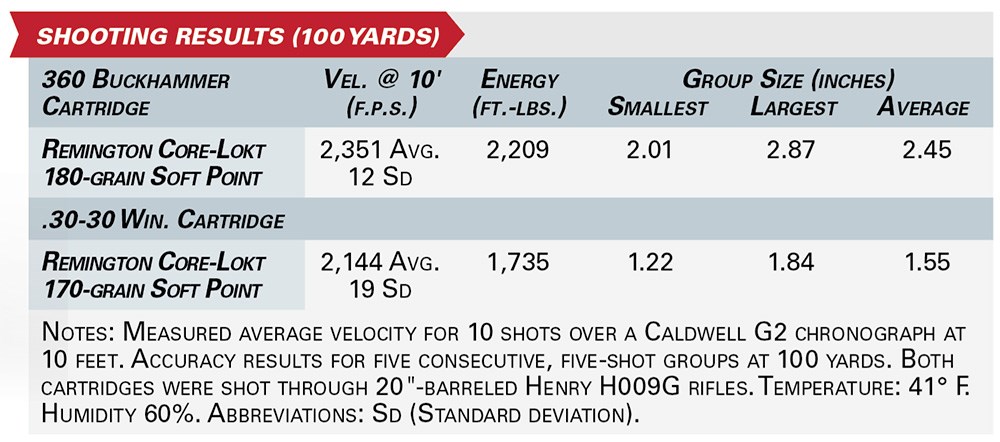
Homework
After a nine-hour drive home accompanied by the most satisfying cigar of my life, I reached out to Remington for some more ammunition to perform an independent comparison test between the .30-30 Win. and 360 Buckhammer cartridges. Putting the 170-grain soft-point Core-Lokt .30-30 round head-to-head with the 180-grain 360 Buckhammer load seemed prudent, particularly since they would be fired from essentially the same rifle. To my surprise, the velocities were exceptionally close to what was advertised, leaving the energy claims entirely intact. Turning my attention to consistency, the .30-30 Winchester’s accuracy beat out the 360 Buckhammer’s by about an inch on our 100-yard targets. That was to be expected, as it had a 128-year head start in the load-development department. On the other hand, there are two deer in my freezer that will testify that it doesn’t amount to enough to matter.
Turning both guns loose on our 200-yard target revealed a fair variance in trajectory that I caution users to be aware of. As we saw an average drop of 11" on our 170-grain soft-point .30-30 Win., the 180-grain Buckhammer impacts only showed up 8" below our point of aim. Kudos to Remington for its work in determining that, as 8" is only 0.2" more than the claim. The groupings at this distance were exceptional, but it’s important to understand that the two have a similar but not identical trajectory; if you are forced to take a tight shot, it pays to know the 360 Buckhammer’s trajectory a little more intimately.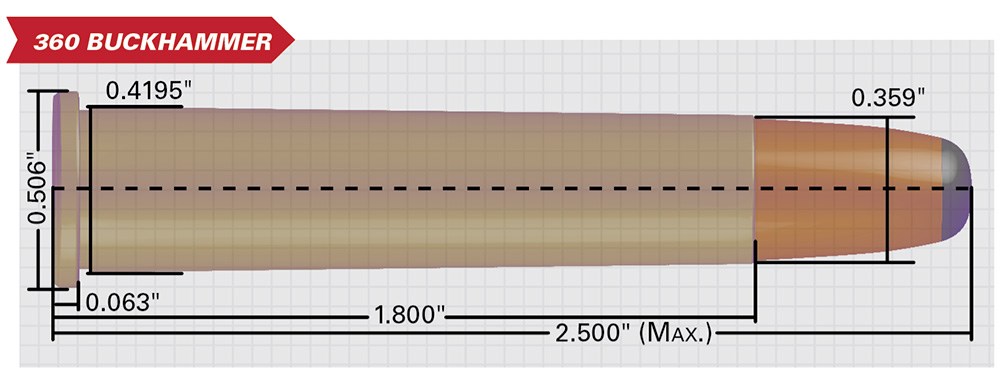
Dropping The Hammer
As I cleaned up my shooting point and headed home to make sense of all of this data, I pondered who else might be interested in this rifle/ammunition combination. Realistically, any hunter who likes shooting .30-30 Win. or found themselves tracking a deer shot with 350 Legend will want to give it a look. I bet this cartridge would make excellent hog medicine as well, as it hits harder than both previously mentioned. Stepping away, I contemplated what the future might hold for the 360 Buckhammer, as I’d be especially interested in seeing a heavier, subsonic load in a shorter rifle. Likewise, as it’s a rimmed design, it could also be chambered in a revolver, making it exceptionally interesting to wheelgun hunters. I guess, when you look at it, Remington's 360 Buckhammer represents one of the better paradoxes in the shooting industry. Since, for something intended for short range, it might have the broadest reach after all.














